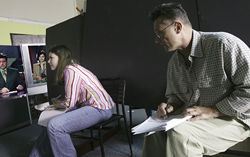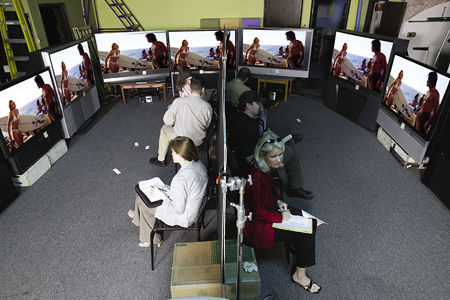The 2004 HD Rear-Projection Face Off Conclusion
So, is that it? Is that all you need to know? Hardly. The most important thing to consider when looking for a new TV is how you're going to use it. Is it going in a room with total light control or in a living room with floor-to-ceiling windows? Are you going to watch only movies, or will you be watching football in the afternoon, news in the evening, and maybe a movie on the weekends? These questions are vital to help you decide what TV to look for.
 Take, for example, the TV that came in first (the Toshiba) and the one that came in last (the RCA). Functionally, they're very similar; both are HDTVs, both have lots of inputs (including DVI), and both cost about the same. The Toshiba relies on three CRTs for its image, while the RCA has a single DLP chip. The Toshiba, when set up correctly, offers about half the light output of the RCA. In a well-lit room (say, on a Sunday afternoon), this can be the difference between seeing everything on the screen and seeing only the bright parts. Even at night, because the RCA puts out so much light, you won't necessarily notice that the TV has a poor black level. In fact, the RCA has a better contrast ratio than the Toshiba; it just has a higher starting and (of course) ending point.
Take, for example, the TV that came in first (the Toshiba) and the one that came in last (the RCA). Functionally, they're very similar; both are HDTVs, both have lots of inputs (including DVI), and both cost about the same. The Toshiba relies on three CRTs for its image, while the RCA has a single DLP chip. The Toshiba, when set up correctly, offers about half the light output of the RCA. In a well-lit room (say, on a Sunday afternoon), this can be the difference between seeing everything on the screen and seeing only the bright parts. Even at night, because the RCA puts out so much light, you won't necessarily notice that the TV has a poor black level. In fact, the RCA has a better contrast ratio than the Toshiba; it just has a higher starting and (of course) ending point.
 So perhaps you're now asking, what was the point of this Face Off? Excellent question. I'm glad you asked. There was really no other way to do this Face Off than what you see here. It turns out that our participants would rather have a deep black level than a higher overall light output. After all, we are Home Theater magazine, not Pretty TV in a Den magazine. In a pure home theater environment, that would be that.
So perhaps you're now asking, what was the point of this Face Off? Excellent question. I'm glad you asked. There was really no other way to do this Face Off than what you see here. It turns out that our participants would rather have a deep black level than a higher overall light output. After all, we are Home Theater magazine, not Pretty TV in a Den magazine. In a pure home theater environment, that would be that.
However, not everyone has a pure home theater, and, at their core, these are still TVs, which you're bound to watch at all hours. All of the reviewers mentioned that the fixed-pixel displays looked better when the house lights came up. They also mentioned that they could see the fixed-pixel devices better at different viewing angles and distances. The CRTs have a much smaller sweet spot. Also, if you crank out your CRT display's maximum light output all the time, you're bound to burn it in. Burn-in is even more likely if you play a lot of video games or watch a lot of CNN. With DLP or LCD (or LCOS), you don't have to worry about burn-in at all.
 In this Face Off, our primary concern was picture quality. If that's all you care about, then your choice is clear. However, if you're looking for an all-around TV, each of these sets offers something different. These new CRTs are the pinnacle of a long tradition. Then again, with the new technologies out there, you no longer have to keep the blinds closed all day if you don't want to.
In this Face Off, our primary concern was picture quality. If that's all you care about, then your choice is clear. However, if you're looking for an all-around TV, each of these sets offers something different. These new CRTs are the pinnacle of a long tradition. Then again, with the new technologies out there, you no longer have to keep the blinds closed all day if you don't want to.
All I know is, I'm never doing this again—well, at least until next time.




























































